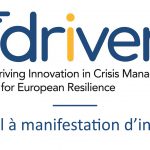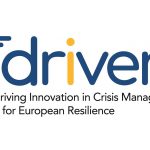DRIVER+ completes the second of four Trials, a core part of this European demonstration project’s focus on innovation and resilience in Crisis Management.
DRIVER+ Trial 2 was held from 22 to 26 October in France at the premises of Entente Valabre, a public Civil Protection support organisation located near Aix-en-Provence.
This event brought together seventy participants from all over Europe, including practitioners from the civil protection and Crisis Management sectors, solution providers, experts and observers. The main goal of Trial 2 was to assess to which extent innovative solutions could improve cooperation and coordination between different organisations and agencies from different countries in a large-scale crisis situation.
#Trial2 of the #DRIVER+ project is starting at the premises of @EntenteValabre in France. During this week, practitioners, solution providers, experts will test four innovative #CrisisManagement solutions under the scenario of a threatening wildfire. https://t.co/SotViiFl0n pic.twitter.com/vtaoFlQxPd
— DRIVER PROJECT (@DRIVER_PROJECT) 22 octobre 2018
After an open selection process, four solutions were assessed in a simulation-based command post Trial which focussed on the scenario of a large forest fire in southern France, threatening nearby towns and an industrial chemical plant. Trial 2 simulated the widespread effects of this scenario in a depiction of real events where multiple other incidents happen in quick succession following a main event. This creates major problems for the first responders and poses a significant challenge for all Crisis Management professionals at all levels, requiring a common understanding among all actors involved. The European Civil Protection Mechanism was also activated, which brought Italian firefighters into the operations. In addition, there was also support from the Italian Red Cross.
The main objective posed to the practitioners was of course to extinguish the fire, enabling them to protect local residents, deal with the casualties, and protect goods, infrastructure and the environment. Trial 2 addressed six gaps in Crisis Management related to the exchange of information and coordination between agencies and organisations, including limits in identifying the location of victims and the ability to incorporate accurate and verified information.
The activities took place entirely within a virtual environment, created by the XVR fire simulator, in which practitioners were located in multiple command rooms with terminals connected to the DRIVER+ Test-bed infrastructure – the tool that sets up the Trial’s testing environment. During the Trial, the DRIVER+ Test-bed infrastructure connected the solutions for data exchange, presented the scenario to the participants and controlled its storyline and timeline. It also recorded and collected the observations and logs throughout the Trial. A series of events was triggered in
the virtual environment, which required practitioners to respond and to assess the suitability and effectiveness of the four solutions.
#Trial2 participants are attending a presentation of the #solutions that will be assessed during the Trial. This will be followed by a hands-on session, where participants will try the solutions themselves. pic.twitter.com/rEtlykepzE
— DRIVER PROJECT (@DRIVER_PROJECT) 23 octobre 2018
The four solutions trialled focused on information sharing between agencies of different countries, especially on assisting the practitioners with visualising and organising the available information in real time, as well as with managing casualties and obtaining relevant information from social media. The LifeX COP solution “collects Crisis Management information and presents it on a map allowing all the people involved to share the same, up-to-date information”, according to Hannah Goeritz of LifeX COP’s developer, Frequentis. Information is fundamental in Crisis Management and Trial 2 put information sharing at its core. The CrisisSuite solution allows its users to “log information about the current situation, the assessment of the situation and the decisions and actions
taken. Actions can automatically be sent down the chain of command to the people responsible for executing them. A crisis team can follow the proceedings of the actions in a simple overview”, as explained by René de Jong of CrisisSuite developer, Merlin Software.
#Trial2: the first session has begun at the premises of @EntenteValabre. The practitioners are being presented with the scenario of a quickly-spreading forest fire and will be assessing the effectiveness of four innovative #CrisisManagement solutions. pic.twitter.com/fAunN4PMhb
— DRIVER PROJECT (@DRIVER_PROJECT) 24 octobre 2018
The scenario in Trial 2 also included the quick emergency management of casualties. To this end, the MDA Command & Control solution (developed by Magen David Adom) created an integrated system that allows the dispatcher to receive all the critical information needed (for example, the patient’s vital medical information or current traffic conditions) and to manage the scene in the most efficient way.
Finally, Trial 2 emphasised the importance in Crisis Management of gathering relevant information from social media. The SMAP solution (Social Media Analysis Processing), developed by Thales Communication & Security, stores and processes a large volume of data, which can be used to help the incident commander make better-informed decisions. SMAP contains an event detection function that automatically detects a sudden increase in the usage of certain keywords, as well as filtering functions based on content, which in turn helps in finding relevant information faster and detecting trends during a crisis.
Gaps #Trial2 will address: shortcomings in the ability to exchange crisis-related information among agencies and organisations. #interoperability pic.twitter.com/xbOeGdhtA0
— DRIVER PROJECT (@DRIVER_PROJECT) 24 octobre 2018
Views of practitioners during the Trial indicated that the solutions do indeed have some very useful functionality and could certainly add value to their operations. Emanuela Fraccaroli of the Italian Red Cross indicated that the solutions “have a lot of potential” but that their scope would be improved even further by “including more information”. Geoffroy Samour, of DREAL, the French government’s environmental protection directorate, pointed out that the solutions trialled make the communication and information exchange “faster and clearer” across organisations, while pointing out that there are still “differences between how the solutions work and organisations work”.
#Trial2 continues this afternoon at the premises of @EntenteValabre, as the scenario advances and the threat escalates. #CrisisManagement #innovation #resilience #interoperability pic.twitter.com/EQYReULMen
— DRIVER PROJECT (@DRIVER_PROJECT) 24 octobre 2018
Trial 2, like its predecessor, is a crucial stage in the DRIVER+ project. The Trials act as tangible demonstrations of the DRIVER+ approach towards innovation in Crisis Management. Each Trial assesses several innovative solutions and adapts them to operational constraints. This not only allows practitioners to come into contact with new socio-technical innovations in their fields, but it also contributes to the development of a pan-European Crisis Management culture. Each Trial also feeds the project’s Test-bed and represents a unique opportunity for a transformative
change regarding assessing the value of innovative solutions in resilience and Crisis Management.
The next DRIVER+ Trial will be held in The Netherlands in May 2019. The main event will be a large flood, threatening over 500,000 residents in the Haaglanden region.
Crisis Management capabilities that will be addressed during this Trial refer to :
- Planning of resources (qualified personnel and equipment) for response during large scale and long-term crises;
- Capability to exchange crisis-related information among agencies and organisations on various levels (interoperability);
- Planning and managing large scale evacuation of population in urban areas.
If you are a Crisis Management professional interested in assessing innovative solutions, or a solution provider developing and deploying socio-technical solutions for Crisis Management professionals, we would like to invite you to become part of DRIVER+. Please visit www.driver-project.eu/collaborate-with-us/externalcooperation-platforms/ and register to get involved.
Further details of the DRIVER+ project are available from the website http://www.driver-project.eu.



